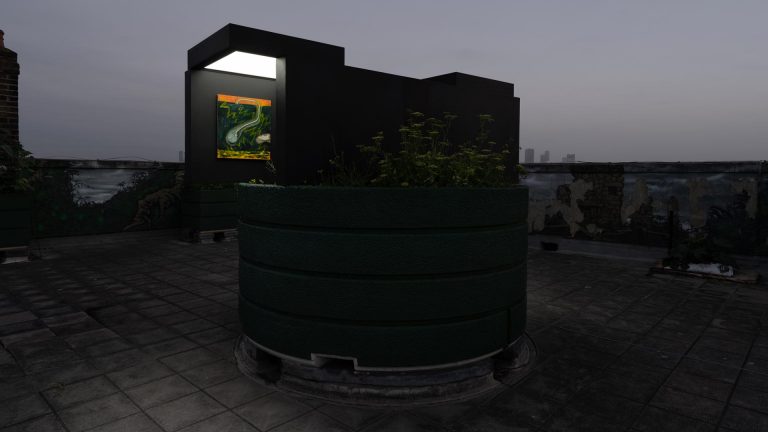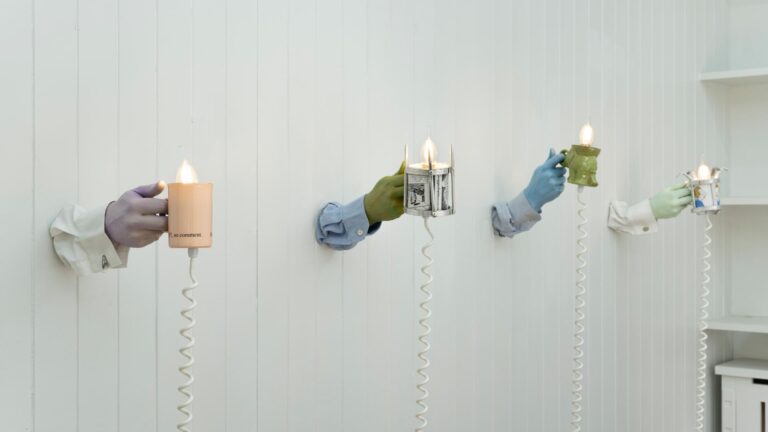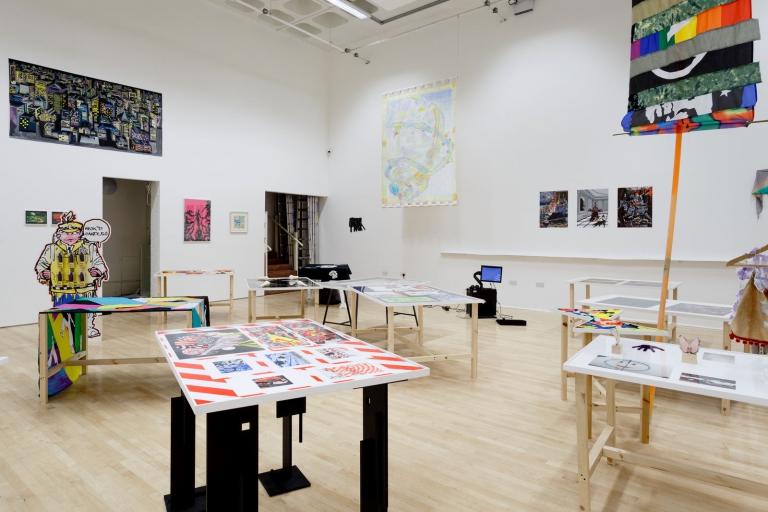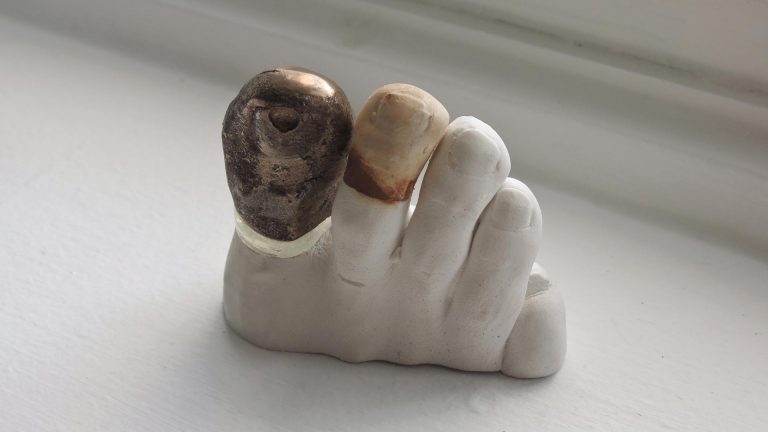Artist: Merike Estna
Exhibition title: The House of the Tragic Poet
Venue: Bosse & Baum, London, UK
Date: November 26, 2021 – January 29, 2022
Photography: all images copyright and courtesy of the artist and Bosse & Baum, London
The House of the Tragic Poet is one of the most famous Roman dwellings of Pompeii. Despite its modest size it still preserves some of the finest mosaics of the archeological site, among which one of a black domestic dog leashed and chained to an arbitrary point of the vestibule’s floor. The name of this ancient house gives the title to Merike Estna’s second solo show at Bosse & Baum, The House of the Tragic Poet, where the artist continues her investigation into painting, craft, technoromanticism, history and mythology within the domestic, the feminine and the everyday, while also exercising empathetic acts of embodiment and interpretation.
A large hand-woven rug depicting a similar subject to the Pompeiian mosaic, covers the gallery floor occupying most of the entrance and the exhibition space. Rhomboid black tesserae-like shapes populate a sky-blue background where the grey silhouette of a dog, free from any domestic chains, wildly inhabits the infinite space of sky and sea. Unlike its original, the shape of the dog looks like a grey cloud, a track left by something erased digitally or dissolved virtually, emblematically capturing some of Estna’s long-standing trademarks in her work, such as her interest into incorporating digital visual idioms within more traditional mediums – painting or textile for example – as well as toying with the boundaries between figuration and abstraction or presence and absence as a way to address the transient nature of the now continuously evolving within its cycles and drastic changes, well represented within the mythological and folk subjects and symbols dear to the artist and existing in her practice. Together with the dog, there are other figures that populate the rug and spill out in the gallery space appearing in the rest of the exhibiting works. Among these, a crouched human silhouette whose position and tattooed skin create a tribal glitch: frozen between past and present, the figure has no precise identity and belongs to all temporalities, future included. Despite their contemporary character, the tattoos populating the humanoid shape generate a rich landscape of symbols referring to all-times cosmological concerns such as divine providence or the cyclical nature of civilization’s rise and fall, day and night, life and death and so on, acquiring a certain relevance in the context of the show.
Estna proposes interpretative versions of the Pompeii house’s decorative patterns as well as its unknown inhabitants, extinguished after the catastrophic eruption of Mount Vesuvius in 79 A.D. By re-imagining their most intimate environment, the artist looks at lost legacies and explores the interpretative potential that lies within the ruins of the past, while also questioning her own tracks, residues of present and past actions, left behind as future ruins. As Federico Campagna recently proposed during a discussion as part of the 2nd Riga International Biennial of Contemporary Art titled “World-ing, or: How to Embrace the End of an Era”, the legacies of fallen cultures often form part of the new narrations that come afterwards. The potential of ruins is to be found thus in their lack of detailed information, which makes it possible for posterior cultures to interpret and inspire different ways to understand reality. Using complex layering techniques as well as blurring effects which transform once detailed patterns into fading backgrounds and grids, Estna voyeuristically looks into the private dimension of lost archaic stories and at the same time becomes an archeologist of her own past, displaying old works together with a selection of newer paintings whose colorful patterns, symbols and forms move beyond the limits of the canvas, erupting into life at the moment when the end feels worryingly close. The result is the suggestion of a complex and yet un-understood web of temporalities where the past becomes uncannily present, and future. A young girl with her pale skin reddened by the sun observes the viewer while suspended into a bright sky with spare clouds, in the company of some doves. Her wise gaze guards eternal secrets… perhaps it is not a coincidence that a pair of doves also appears on the rug on the floor, as well as possible fragments of clouds and a similar unreal bright sky-blue, framed by the mosaic motif and beyond it at the same time; inhabiting multiple narrations of the world – or dimensions – one might say. A mysterious figure appears in a cream, a-temporal zone of the textile as well as in the background of a painting. Although being the only figure with some facial traits, its sinuous curves make it a ghostly presence. It holds a jar, which references some of the ceramic objects used by a nude male performer in an older work which the artist presented both as part of the 13th Baltic Triennial and in her first solo exhibition at the gallery. If the well-known performative character of Estna’s work is seemingly absent in this show, its track constitutes a new mark in which the fluidity of the boundaries of the medium of painting emerges once again. A mask inhabits the same “outside of time” region of the rug; its tragically curved mouth and hollow eyes are then on a painting too, superimposed on a psychedelic gridded backdrop of virtual nature. The serpentine lines of the grid seem to link to the many snakes present in the works of the show, recalling once again cycles, alternating times and epistemological short-circuits in all their fascinating latency.
In such a chaotic landscape of romantic gestures, existing among the private and the metaphysical, both forgotten legacies and future ruins reveal the potential for new sinuous narrations, twisted between past and present and exploring vocabularies that exist in the detailed layers and blurred backgrounds of Estna’s work.
Merike Estna, The House of the Tragic Poet, 2021, exhibition view, Bosse & Baum, London
Merike Estna, The House of the Tragic Poet, 2021, exhibition view, Bosse & Baum, London
Merike Estna, The House of the Tragic Poet, 2021, exhibition view, Bosse & Baum, London
Merike Estna, The House of the Tragic Poet, 2021, exhibition view, Bosse & Baum, London
Merike Estna, The House of the Tragic Poet, 2021, exhibition view, Bosse & Baum, London
Merike Estna, The House of the Tragic Poet, 2021, exhibition view, Bosse & Baum, London
Merike Estna, The House of the Tragic Poet, 2021, exhibition view, Bosse & Baum, London
Merike Estna, The House of the Tragic Poet, 2021, exhibition view, Bosse & Baum, London
Merike Estna, The House of the Tragic Poet, 2021, exhibition view, Bosse & Baum, London
Merike Estna, The House of the Tragic Poet, 2021, exhibition view, Bosse & Baum, London
Merike Estna, The House of the Tragic Poet, 2021, exhibition view, Bosse & Baum, London
Merike Estna, Peace?, 2005, oil on canvas, 300 x 200 cm
Merike Estna, Trapped in memory and lost in gaze, 2019, acrylic and oil on canvas, 45 x 61 cm
Merike Estna, Irreversible, past and present, 2019, oil on canvas, 45 x 61cm
Merike Estna, The ghost, the past and the fence, 2021, acrylic and oil on canvas, 160 x 220 cm
Merike Estna, The House of the Tragic Poet, 2021, Hand tufted wool, 364 x 577 cm
Merike Estna, The House of the Tragic Poet, 2021, Hand tufted wool, 364 x 577 cm
Merike Estna, The House of the Tragic Poet, 2021, Hand tufted wool, 364 x 577 cm
Merike Estna, The House of the Tragic Poet, 2021, Hand tufted wool, 364 x 577 cm
Merike Estna, The House of the Tragic Poet, 2021, Hand tufted wool, 364 x 577 cm
Merike Estna, The House of the Tragic Poet, 2021, Hand tufted wool, 364 x 577 cm
Merike Estna, The House of the Tragic Poet, 2021, Hand tufted wool, 364 x 577 cm
Merike Estna, The House of the Tragic Poet, 2021, Hand tufted wool, 364 x 577 cm
Merike Estna, The House of the Tragic Poet, 2021, Hand tufted wool, 364 x 577 cm






























